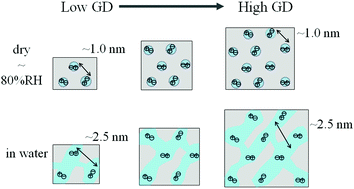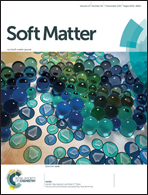Imidazolium-based anion exchange membranes for alkaline anion fuel cells: (2) elucidation of the ionic structure and its impact on conducting properties†
Abstract
In our previous study (Soft Matter, 2016, 12, 1567), the relationship between the morphology and properties of graft-type imidazolium-based anion exchange membranes (AEMs) was revealed, in that the semi-crystalline features of the polymer matrix maintain its mechanical properties and the formation of interconnected hydrophilic domains promotes the membrane conductivity. Here, we report a novel ionic structure of the same graft-type AEMs with different grafting degrees, analyzed using a small-angle X-ray scattering method under different relative humidity (RH) conditions. The characteristic “ionomer peak” with a corresponding correlation distance of approximately 1.0 nm was observed at RH < 80%. This distance is much smaller than the literature-reported mean distance between two ionic clusters, but close to the Bjerrum length of water. Since the representative number of water molecules per cation, nw, was small, we proposed that dissociated ion-pairs are distributed in the hydrophilic domains (ion-channels). At RH < 80%, ion-channels are disconnected, however in liquid water, they are well-connected as evidenced by the sharp increase in nw. The disconnected ion-channels even under relatively high RH conditions should be a substantial factor for the low power generation efficiency of AEM-type fuel cells.



 Please wait while we load your content...
Please wait while we load your content...